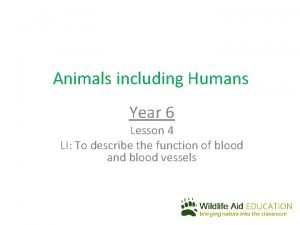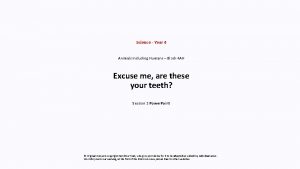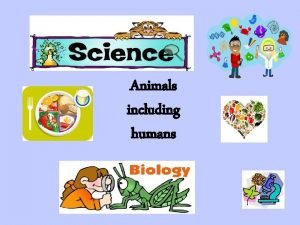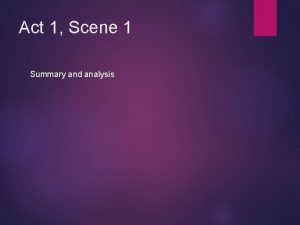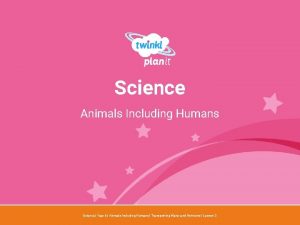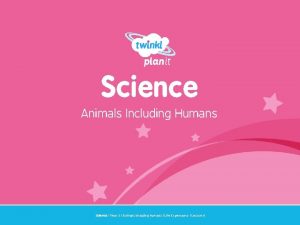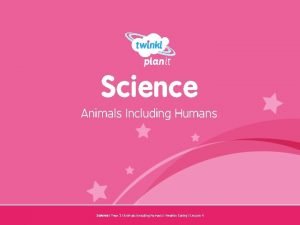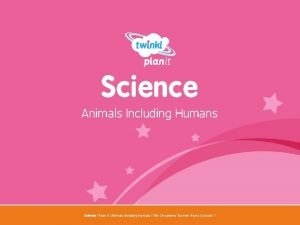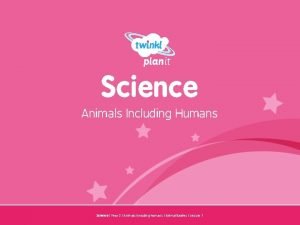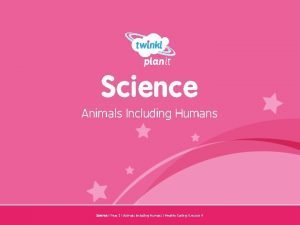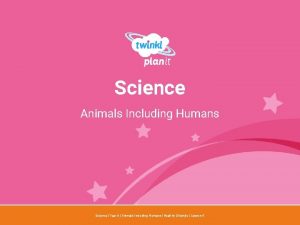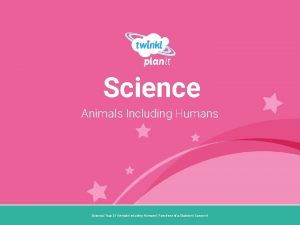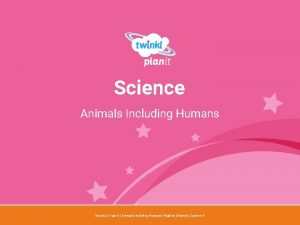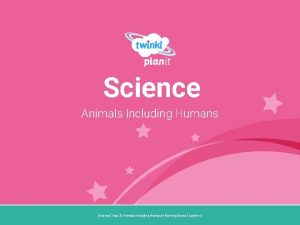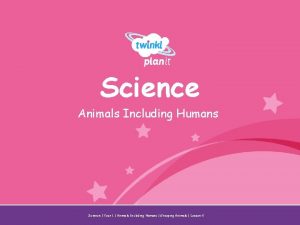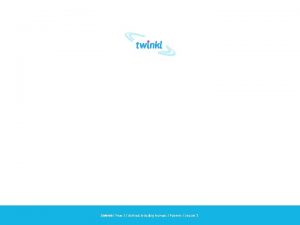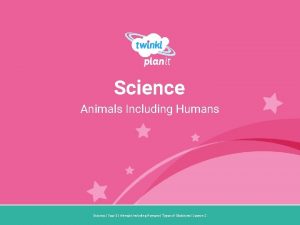Science Animals Including Humans Year One Science Year















- Slides: 15

Science Animals Including Humans Year One Science | Year 6 | Animals Including Humans | Transporting Water and Nutrients | Lesson 3


Aim • I can explain how water and nutrients are transported within the body. Success Criteria • I can state how the digestive system breaks down nutrients. • I can explain the role of circulatory system in transporting nutrients and water in the body.

Why Do We Need Nutrients? Match the type of nutrient with the job that it does. Help the body to grow and repair itself. Gives the body energy so we can be active. Help the body to stay healthy. For example Vitamin C helps wounds to heal. Gives the body energy, stores energy and helps insulate against the cold. Keep the body healthy. For example: calcium keeps our teeth strong and iron is needed to help circulate oxygen around the body. Helps keep food moving through the colon and intestines. Needed for bodily fluids and normal cell function.

1 Humans get nutrients from food and drink. This is broken down digestive system. 4 by the 3 Can you remember the functions of the digestive system? 2 5 8 6 9 10 7 12 11 13 14

How Does It Work?

How Does It Work? How Are Nutrients Broken Down? Stomach acids break food down into a substance called chyme. This passes through to the duodenum where bile and enzymes break up larger molecules into their smaller parts. Starch molecule Sugar molecules Carbohydrase enzymes break down starch (in carbohydrates) into sugars. carbohydrase Protein molecules Amino acid molecules protease Fat molecules Fatty acid and glycerol molecules Protease enzymes break down proteins into amino acids. (Not to be confused with stomach acid!) These are essential to help the body to grow and repair body tissue. In the duodenum, bile from the liver breaks down fat. Then the lipase enzymes break the fat down further into fatty acids and glycerol.

A Closer Look How Does It Work? After the nutrients have been broken down into smaller separate molecules in the duodenum, they can then pass through to the rest of the small intestine, where they are absorbed into the blood stream. Inside the Small Intestine muscle layers serosa villus submucosa The small intestine is a muscular tube with several layers. It is lined with tiny hair like villi which are attached to arteries and veins. The chyme (which now contains smaller broken down nutrient molecules) is moved back and forth in the small intestine. The nutrients pass through the villi and are absorbed into the blood vessels. villi vein artery Bacteria in the large intestine break down waste food for any more nutrients which are absorbed. This process also leads to gas which is eventually passed through the anus.

How Does It Work? What about Water? Water enters the body in the mouth. Unlike other nutrients it is not broken down by enzymes or bile. A small amount of water is absorbed through the stomach but the majority passes through to the small intestine. Water is absorbed in the small intestine in the exact same way as other nutrients are absorbed – through the villi into bloodstream via the blood vessels. The large intestine (also called the colon) is similar to the small intestine in structure except that it does not contain villi. By the time waste material reaches the large intestine, 90% of water has already been absorbed. The waste food enters into the cecum which is the first part of the large intestine. It moves through the large intestine through a series of mass movements. These are long, slow moving waves of muscles contracting and relaxing. The rest of the water in the waste food is absorbed in all the different parts of the colon. The resulting stool and any gases are moved to the sigmoid colon. It is this part of the large intestine that enables gases to be released without releasing stools at the same time. The stools then enter the rectum before expulsion through the anus.

How Does It Work? How Does It All Fit? Nutrients and water are absorbed in the system in the stomach, small and large intestines. They enter the blood stream via the capillaries where they are passed through to the arteries. The blood is circulated throughout the body (including being oxygenated in the lungs and the heart). Nutrients are absorbed by the cells that need them and water is absorbed by all cells.

How Does It Work? How Is Waste Expelled from the Body? kidney bladder urethra There are kidneys are responsible for getting rid of waste from blood in two ways. 1. Veins collect waste from cells. Most of the waste is released into the liver. The liver then uses it to create bile. This goes into the duodenum to break down food into chyme. The waste that is not turned into bile is made water soluble (dissolves in water) and goes to your kidneys. 2. The kidneys perform a function called filtration. The renal vein delivers blood to the kidneys which it filters for waste. This is called ultrafiltrate and is turned into urine which is passed through to the bladder. The bladder serves the same function as the rectum, in that it sends signals to the brain. It sends signals to indicate that urine needs to be expelled. Urine is then released through the urethra.

Explanation Diagram In groups, you will create diagrams explaining how nutrients and water are transported around the body. Use the notes that you have written down to support you. You may ask an adult if you are unsure about any of the information or ask to see the appropriate information again. Make sure that your diagrams are clear and can be understood by others by making your handwriting neat and easy to read, and checking that your sentences make sense.

Presentation You will now present their diagrams to the rest of the class. If you are listening: • Pay attention to the parts of the diagram being shown. • Listen carefully to the speaker. • If you are unsure about something that has been said, make a note of it. • Ask questions at the end rather than during the presentation, unless there is a factual error. In this case, get the speakers attention in an appropriate way (e. g. hands up) and wait for them to finish speaking before you do. • If you think you have made an error on your diagram, wait until the end of the presentation, you will be given time to correct if necessary. If you are presenting make sure: • Everyone can see your diagram – decide if you want to hold it or blue tack it to a wall. • Explain your diagram and what you have included as part of it. • Speak clearly, slowly and loudly enough so that others can hear what you have to say.

Aim • I can explain how water and nutrients are transported within the body. Success Criteria • I can state how the digestive system breaks down nutrients. • I can explain the role of circulatory system in transporting nutrients and water in the body.

 Animals including humans year 6
Animals including humans year 6 Animals including humans year 4
Animals including humans year 4 Animals including humans
Animals including humans Https://a-z-animals.com
Https://a-z-animals.com Consumers producers and decomposers
Consumers producers and decomposers Parasitic food chain
Parasitic food chain Carnivore
Carnivore Act 1 scene 1 hamlet
Act 1 scene 1 hamlet One empire one god one emperor
One empire one god one emperor Little dog run
Little dog run One king one law one faith
One king one law one faith Byzantine definition
Byzantine definition One ford behaviors
One ford behaviors See one do one teach one
See one do one teach one See one, do one, teach one
See one, do one, teach one Twelfth night speeches
Twelfth night speeches
